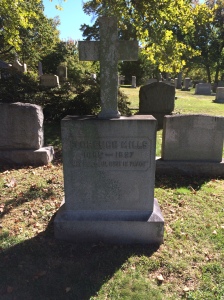While some people in vaudeville were perpetuating stereotypes, others were making inroads in gaining respect and admiration for African Americans. Tiny and frail, but burdened with a sense of responsibility to black America, she literally worked herself to death in its service. Granted, she did it by being a famous star, but the job description for that position includes stress, long hours, constant travel, and almost complete detachment from “normal” life. She was the first black performer to head a bill at the Palace, and the first black woman with her own show on Broadway. Many regarded her almost as a savior. Duke Ellington wrote a piece of music called “Black Beauty” in her honor.
Mills grew up Washington D.C., singing for friends and family from earliest childhood. By age 5, Baby Florence was performing for diplomats, cakewalking and buckdancing with Black Patti’s Troubadors. In 1906, she was employed as a “pick” for a blackface performer knowns as Bonita. Then the Gerry Society put the kabash on her performing, and actually took her away from her parents for a time.

In 1910, she formed a trio with her sisters Olivia and Maude and worked the black circuit. Her sisters dropped out in the mid-teens, so Florence joined “Bricktop” and Cora Green to form the “Panama Trio”. This was in Chicago around the time of the birth of jazz, and the group was right in the thick of it, playing the wild and chaotic night club scene. Over the next few years, Mills was to alternate her time between the Panama Trio and another group, the Tennessee Ten on the Pantages and Keith circuits. The latter group was hired by Nora Bayes for an act called “The Songs We Love to Sing”.

Mills’ crucial break came in 1921, with Sissle and Blake’s Shuffle Along, in which the full force of her talent shone forth, making her a huge star. She went on to enjoy a sustained and greater success than Sissle and Blake themselves, booking a series of prestige dates on both sides of the Atlantic until her death six years later. These included The Plantation Revue, produced by Lew Leslie (1922), the Greenwich Village Follies (1923), the 1923 London show Dover Street to Dixie and its New York version Dixie to Broadway (1924), headlining vaudeville engagements at the Hippodrome and the Palace (1925), the debut of songs by African American classical composer William Grant Still Levee Land at Aeolian Hall (1926), and Lew Leslie’s Blackbirds of 1926. It was on her return voyage from London in 1927 that Mills was operated on for appendicitis, and died at the age of 31. Her resting place is at Woodlawn Cemetery; I visited in 2015:

To learn about the roots of vaudeville including stars like Florence Mills, consult No Applause, Just Throw Money: The Book That Made Vaudeville Famous


[…] https://travsd.wordpress.com/2010/01/25/stars-of-vaudeville-109-florence-mills/ […]
LikeLike
[…] a couple of landmark African American shows produced by Lew Leslie: The Plantation Revue (with Florence Mills) and Dixie to Broadway (with Mills and Willie Covan). In the forties, he was a regular performer in […]
LikeLike
[…] of the jazz age, a huge hit, running over 500 performances. The cast included Josephine Baker, Florence Mills and Paul Robeson. Hit songs included “I’m Just Wild About Harry”, “Love Will Find a Way” […]
LikeLike